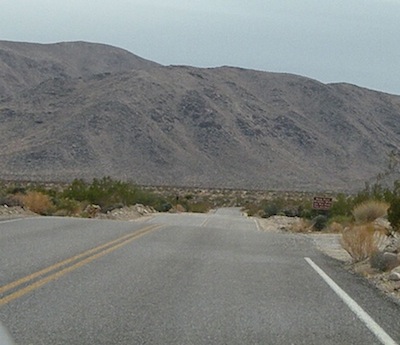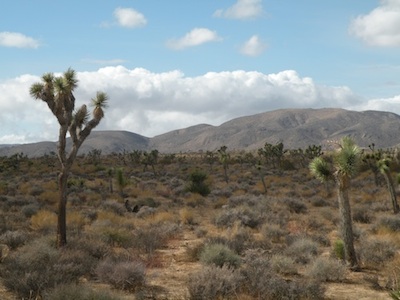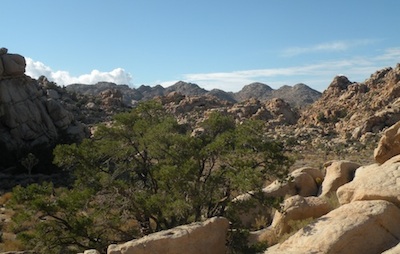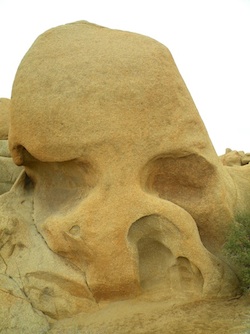
Deserted isolation: Both blessing and curse
TWENTYNINE PALMS, Calif. — When concrete, nightlife and fast-paced days are what you’re used to, the remote and relaxed atmosphere that defines Joshua Tree National Park and Twentynine Palms, Calif., may come as a bit of a culture shock.
What’s more, if you’re used to skyscrapers and, well, pollution, the scenic skyline and crisp and clean air give you a sense of liberation from your otherwise stressful lifestyle.
When people go on vacation, they typically seek an escape from their everyday, to disconnect and rejuvenate. Though resorts and large cities allow you to embark on new experiences, Joshua Tree National Park offers you an adventure.
| Once inside Joshua Tree Nstional Park, visitors can drive miles on end without passing another car and without cell phone service. It is imperative that visitors enter the desert properly prepared to face the harsh conditions in case of any emergency (Photos by Edyna Garcia). |  |
“We come out here typically once a month,” said rock climber and UCLA grad student Nick Infante, 24, in reference to he and his friends who travel the 160 or so miles from Los Angeles to the park. “ It’s nice to get away from the city and the people.”
And a true getaway it is — Joshua Tree National Park, stretching for more than 1,234 square miles of Southern California, takes you into a rocky and mountainous desert, miles away from civilization, not to mention cell phone towers.
Without the cellular ability to even “roam” for service, time in Joshua Tree National Park will be spent free of phone calls, text messages, e-mails and other social media notifications.
“I’ve come out here about once or twice and what I look forward to most is turning off my cellphone and not speaking to anyone but my family members. It’s what makes this trip so valuable to me,” said Adrian Hislop, a 35-year-old attorney and nature lover..
 |
At left, hours into the national park, isolation is evident. For miles, all that is seen are acres of Joshua Trees, desert plants, cacti and mountains. Below, a view from the top of the Hidden Valley mountains. The terrain is an easy climb, more so a trail that leads you up and down the various mountains. |
Despite its nine camping grounds such as Cottonwood and Black Rock Canyon, climbing destinations, such as those in the popular Hidden Valley, and tourist attractions, such as Skull Rock, it’s rare to come across people when simply driving through Joshua Tree and exploring its grassy terrain.
The isolation is almost overwhelming. As you step outside your vehicle, you hear nothing but the faint sounds of nature, which sometimes is not heard at all. It’s a silence so powerful it quiets any group of people taking it in for the first time so as to not disturb the peace.
For miles and hours, you can continue to drive through the national park and continue to see landscapes of mountains, rocks, Joshua trees and other desert plants — and still no single person in sight, including park rangers.
Though the isolation of the desert is clearly a large appeal to tourist and can be considered almost, if not, magical, it is also an imminent threat that is sometimes ignored by those entering the park for the first time.
 Despite its location in Southern California, Joshua Tree National Park is still a desert and, during its hot months, reaches brutal temperatures of up to 120 degrees.
Despite its location in Southern California, Joshua Tree National Park is still a desert and, during its hot months, reaches brutal temperatures of up to 120 degrees.
When entering Joshua Tree National Park, it’s essential to know your way around, be properly equipped for the dry climate and avoid driving through rough terrain.
Entering the park ill-prepared can result (and has resulted) in fatal consequences.
Park Ranger Joe Zarki recalled the case of a Dutch couple, Augustinus Van Hove, 44 and Helena Nuellet, 38 who paid a visit to Joshua Tree in August.
While exploring the park, they attempted to drive their rented Dodge Charger through a rough road, resulting in it getting stuck.
In an attempt to survive, they embarked on a four-hour walk down an eight-mile road in 106 degrees, They died of heat exhaustion by nightfall.
Though death by exhaustion is rare, according to Zarki, it’s important to take the necessary measures to avoid finding yourself in such predicaments, especially since emergency call boxes can be miles away from your location and cell phones have absolutely no service.
“Having a plan, telling someone where you’re going, don’t hike alone if you can avoid it, make sure you have adequate food and water, make sure you have clothing suitable for how long you’ll be out, sunscreen and a hat. That’s what we recommend to people,” explained Zarki.
When you first enter the desert, you often worry about the obvious threats: How do I treat a rattlesnake bite on the spot? How much water should I bring to avoid heat exhaustion? How do I avoid mountain lions?
What visitors don’t ask, however– and sometimes don’t even think about—is how many people use the isolation of a remote place such as Joshua Tree as a refuge from law enforcement?
In the history of the area that is now the park, outlaws such as cattle rustlers often used the land to hide and live without threats. In fact, it was quite common in places such as the park’s Hidden Valley a century ago.
As said above, visitors will walk around Joshua Tree with a sense of confidence that there is no one in sight for miles on end, but, truthfully, one cannot be so sure. Joshua Tree is full of rocky elevations, caves, mountains and several ins and outs, perfect for anyone looking to hide and not be found.
 |
Skull Rock stands alone with its unique resemblance to a skull and serves as a tourist attraction, located along the main east-west park road. |
“I’ve been out here a couple times and, honestly, nothing has ever happened. It wasn’t until I started bringing my kids that I began thinking about the dangers of people,” said Audrey Adames, 31, a mother of two children. “Prior to bringing my little girls out here, I never really thought twice about camping out. Now, I sleep with one eye open. You have to always be careful.”
Though this is a situation you should be more than aware of when entering Joshua Tree National Park, it should not be a deciding factor as to whether or not to visit.
“During June, July and August, over 150 to 200,000 visitors come here and it’s very, very rare that someone has a problem,” explained Zarki.
He later stated that there have only been three accidents in 2011, including a rock climbing accident and the stranded Dutch couple that perished in the heat.
Despite the risks, Joshua Tree National Park is definitely an interesting part of California and well worth the travel.
If You Go
Joshua Tree National Park is located 74485 National Park Dr., Twentynine Palms, Calif. 92277-3597.
For more information on Joshua Tree National Park, visit http://www.nps.gov/jotr or call the visitor’s center at 760-367-5500.
The Joshua Tree Visitor Center and the Oasis Visitor Center are open all year, 8 a.m. to 5 p.m.; the Cottonwood Visitor Center is open all year, 9 a.m. to 3 p.m., and the Black Rock Nature Center is open all year, 8 a.m. to 4 p.m.
For volunteer information, visit http://www.nps.gov/volunteer or http://www.volunteer.gov/gov or call the Park’s volunteer coordinator at 760-367-5528.

Comments are Closed